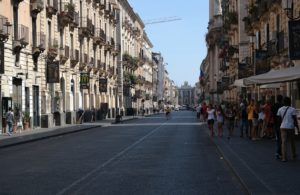For all the scruffiness, chaos, and noise that hit many visitors at first glance, this city has a very strong magnetic pull. Friends of mine that own an Edmonton Chiropractor clinic had amazing things to say about Catania after their trip to the Italian city. The city is packed with gritty and cool bars, an earthy spirit and abundant energy in sharp contrast to the aristocratic airs in Palermo. Here are the top must-see attractions in Catania, Italy.
 Teatro Massimo Bellini
Teatro Massimo Bellini
Made for Vincenzo Bellini – a homegrown composer – and completed in 1890, the opera house in Catania is suitably luxurious, from the marble and stucco luxury of the foyer to the theatre’s glory itself. Its painted ceiling portrays scenes from 4 of the best-known operas of Bellini. The Associazione Turistiche Catania runs a 45-minute guided tour.
La Pescheria
The rowdy fish market in Catania opens every morning and offers visitors pure street theatre. Ruby-pink prawns, swordfish, sea urchins, mussels, clams, and all sorts of sea life are sold here. High-heeled housewives daintily step over ‘bloodied’ water and fishmongers stomach silvery fish. It is absolutely riveting. There are several great seafood restaurants surrounding the market.
Monastero delle Benedettine
This church covers 2 adjacent sides: Chiesa di San Benedetto and Benedictine convent. It was completed in 1713 and decorated with splendid marble, stucco, and a late eighteenth-century altar crafted from Sicilian jasper. The highlight includes the glorious ceiling frescoes by Giovanni Tuccari and a graphic portrayal of Saint Agatha tortured in front of a sultan.
Piazza del Duomo
This UNESCO World Heritage Site is a piece of contrasting limestone and lava, surrounded by structures in the unique baroque style and dominated by the huge Cattedrale di Sant’Agata. At its center is Fontana dell’ Elefante, a naïve elephant dating from the Roman-era and crowned by a fanciful Egyptian obelisk.
Via Etnea
It isn’t hard to see how the main street in Catania got its name – you can see Mount Etna on a clear day majestically rising. Via Etnea runs from Piazza del Duomo to Etna’s foothills. Lined with bars, pavement, and stores, it is busy most times but breathes on Saturdays when shoppers troop in from the suburbs to update their wardrobes. To escape the crowds, go to Giardino Bellini so you can relax in the shady gardens while admiring the views of the volcano.

Cattedrale di Sant’Agata
Inside this cathedral’s vaulted interior, beyond its magnificent marble façade, lie the city’s patron saint relics. The world-renowned composer Vincenzo Bellini is its other well-known resident. His remains were in 1876 transferred here. You can also visit the nearby Museo Diocesano for access to the baths directly under the church.
 Fort Santiago
Fort Santiago